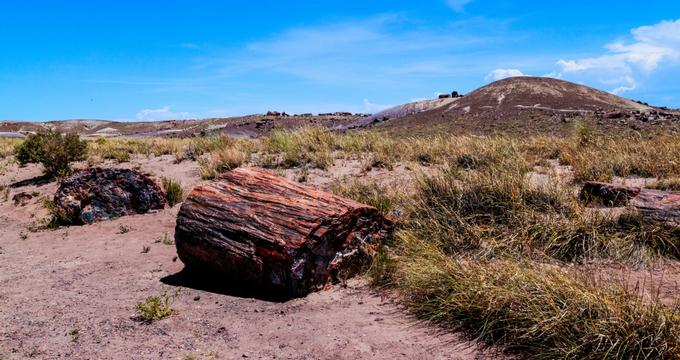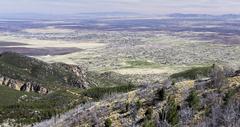Located in Apache and Navajo Counties in northeastern Arizona, Petrified Forest National Park is a 230-square-mile park named for its deposits of petrified fallen tree fossils from the Late Triassic Period. Much of the unique geology of the Petrified Forest area is formed from sediments containing fossilized logs of trees from the Late Triassic Period, which occurred around 225 million years ago.
History
The sediments of this fossilized material, which also includes smaller plant life and animal remains from the Late Triassic, is referred to as the Chinle Formation where it appears within the boundaries of the Petrified Forest. An assortment of sedimentary rocks, including soft mud, silt, and bentonite clay, as well as harder limestone and sandstone, formed a unique multicolored pattern of rock in the area. Around 60 million years ago, tectonic activity in the area that now encompasses the southwestern United States caused the Colorado Plateau area to be pushed upward more than 10,000 feet above sea level, exposing the rock formations to erosion by wind and water. As a result, the area has been carved into colorful badlands formations comprised of cliffs, mesas, and rounded hills.
Humans have inhabited the Colorado Plateau area for more than 13,000 continuous years, first arriving in nomadic tribes at the end of the last Ice Age. The earliest inhabitants of what is now the Petrified Forest arrived around 8,000 years ago, transitioning from early hunter-gatherer societies into the agricultural communities of the Ancient Pueblo people, though persistent dry climate conditions caused mass migration away from the area by the 15th century. European settlers passed through the area throughout the 16th through 19th centuries, dubbing the area the Painted Desert due to the variety of rock sediment coloring.
Commercial development of the area throughout the 1800s led to an increased interest in the use of petrified wood as commercial material, and as a result, an increase in interest in the preservation of the material. Excavations throughout the late 19th and early 20th centuries uncovered more than 500 historic indigenous archaeological sites, along with a large number of prehistoric skeletons and other fossils. The earliest attempts to preserve the area as a national park date back to 1895, and a decade later, the Antiquities Act by President Theodore Roosevelt established the area as a national monument. The monument was designated as a national park in 1962, and several preservation acts since have worked to combat the problem of theft and vandalism of petrified wood within the park.
Attractions
Today, the park encompasses around 230 square miles, bordered by the Navajo Nation on its northern and northeastern ends, and serves around 650,000 annual visitors. Its elevation ranges from 5,340 feet to 6,230 feet above sea level, featuring a major concentration of its petrified wood deposits in its southern end. The park’s climate is dry and windy, experiencing wide temperature variation throughout the year, ranging from freezing temperatures in the winter to summer highs of more than 100 degrees Fahrenheit. More than 447 flora species are native to the area’s semi-desert shrub steppe climate, including more than 100 unique species of grass. Animal life found in the park includes coyotes, bobcats, pronghorns, jackrabbits, and 216 species of migratory and permanent resident birds.
The park’s headquarters are located 28 miles east of the city of Holbrook and are accessible via Interstate 40. The Painted Desert Visitor Center, part of the Painted Desert Community Complex Historic District, provides visitor information and shows a 15-minute park orientation film, Timeless Impressions. Nearby, the Painted Desert Inn provides lodging for park visitors and contains murals that serve as a museum exhibit dedicated to Hopi tribal life. On the southern end of the park, the Rainbow Forest Museum displays exhibits showcasing petrified fossils and wood recovered from the park and provides information on the area’s prehistoric life.
Several overlooks near the Visitor Center provide views of the park’s Painted Desert areas, including Chinde Point, which offers picnic facilities, and Tawa Point, which serves as a trailhead for the mile-roundtrip Painted Desert Rim Trail. South of historic Route 66 and the Burlington Northern Santa Fe Railroad, which intersect the park from east to west, the Puerco Pueblo archaeological site showcases the excavated remains of Pueblo structures from more than 600 years ago, and nearby Newspaper Rock features more than 650 ancient petroglyph rock carvings. The Jasper Forest area is home to the park’s largest accumulation of petrified wood, while the Blue Mesa, Crystal Forest, Long Logs, Giant Logs, and Agate House trails provide hiking routes of varied length and difficulty.
In addition to self-guided hiking and backpacking along the park’s trails, horseback riding is permitted within the park’s grounds. Permit camping is permitted in the park’s Wilderness Area, located north of the Visitor Center and accessible via the Kachina Point access trail. Cultural demonstrations are presented throughout the park periodically, showcasing indigenous traditions, and ranger-led guided hikes are offered seasonally. The Petrified Forest Field Institute offers courses related to various history, archaeology, and cultural topics, and an artist-in-residence program brings a variety of multimedia artists to the park to create works and present demonstrations in natural surroundings.
1 Park Road, PO Box 2217, Petrified Forest, AZ 86028, Phone: 928-524-6228





